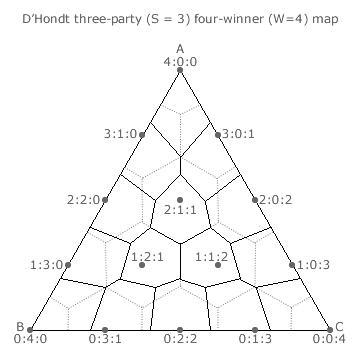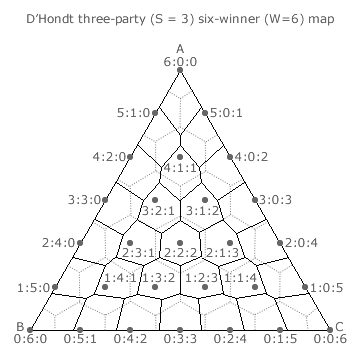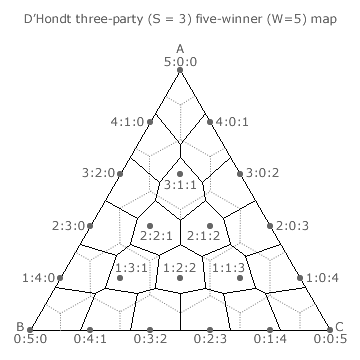Comparisons: D'Hondt ~ Maps 3
Three-Party D'Hondt Party-List Maps (continued)
The domains on any three-party map are necessarily hexagonal; unless truncated by a map edge. However, it is obvious that D'Hondt domains are not regular hexagons. Just like CHPV domains, each critical section of a two-way tie line (that defines a domain boundary) is always in line with one of the three map apexes. Indeed, as part of the construction of the map, a two-way tie line is first drawn from the relevant apex to the correct point on the opposing base before the critically-tied section of it is identified.
The three-party D'Hondt and CHPV domains feature irregular inner hexagons with boundaries in line with an apex. This is a result of both systems being a highest averages method. In contrast, the Hare Quota (OPV) and Droop Quota domains feature regular inner hexagons with boundaries that are at right-angles to the relevant base (map edge). These features occur as both quota systems employ the largest remainder method.

A noticeable aspect of the D'Hondt domains is that for any given three-party map they all have roughly the same area whether they are in the interior or on the periphery of that map. This aspect is independent of how many seats/winners there are. Also, perfect proportionality is always achieved when the (rare) opportunity arises since every seat share dot appears in its own corresponding D'Hondt seat share domain.
Two corresponding D'Hondt and OPV domain boundaries are at their closest in the centre of the map but steadily diverge as they approach an apex of the map. At the edges of a map, the two corresponding boundaries are however necessarily equal as the domains terminate here. Therefore, the D'Hondt method is more likely to produce an optimally proportional outcome when the three parties each have comparable rather than dissimilar levels of support. This feature is largely independent of the number of seats available.
As the number of winners increases, extra domains and boundaries appear on the map. With more boundaries, there are more portions within the map where points occur in dissimilar domains. However, with more domains, these portions are smaller in area. As for the two-party ones, the net effect of these two conflicting features is that the optimality of three-party D'Hondt Party-List elections deteriorates slowly as the number of winners increases; see next section.


Proceed to next section > Comparisons: D'Hondt ~ Optimality
Return to previous page > Comparisons: D'Hondt ~ Maps 2
